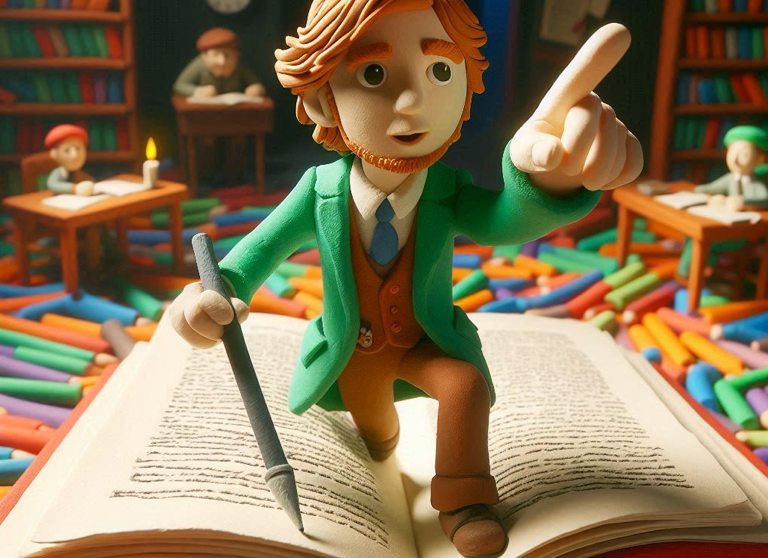In this post on the types of narrators series, I will discuss the second-person narrator, a rarely used narrative style in novels or stories that can be quite challenging. It is important to understand this style as it may prove useful at some point.
The main characteristic of the second-person narrator is the use of “you” to directly address the reader and position them as the protagonist of the events. However, this may not always be the author’s intention, as we will see later.
There are two types of second-person narrators: one corresponds to the epistolary genre, and the other involves a narrator speaking directly to the reader.
The Epistolary Genre
The epistolary genre is the most common and easiest to write of the two types of second-person narrator. It simply consists of a character, or the author themself, writing a letter to another character and addressing them in the second person as “you.”
This genre brings realism to the story, turning the reader into a witness of the correspondence between two people. However, it has the limitation that everything that is conveyed has to be done through letters, and it is not always easy to create a setting or describe certain passages without it sounding forced. Nevertheless, there are entire novels written as an exchange of letters between two people—or even emails—that work like a charm.
📚 Excerpt of “Pamela or Virtue Rewarded” by Samuel Richardson: Dear Pamela,Your letter was indeed a great trouble, and some comfort, to me and your poor mother. We are troubled, to be sure, for your good lady’s death, who took such care of you, and gave you learning, and, for three or four years past, has always been giving you clothes and linen, and every thing that a gentlewoman need not be ashamed to appear in. But our chief trouble is, and indeed a very great one, for fear you should be brought to anything dishonest or wicked, by being set so above yourself.
The Narrator Speaks to the Reader
The other second-person narrator is the one who speaks directly to the reader, and the one I want to focus on here since it is a complex narrator to use but also an interesting literary device.
The second-person narrator who speaks to the reader is not always used in the same way or for the same purposes. I will analyze some different examples and how they work.


Let’s start with the case of Paul Auster in his memoir “Winter Journal,” written entirely in the second person narrator. My feeling in this book is that the author uses the second person not so much to address the reader directly but to create a certain distance between himself and the memories he is writing. This is a valuable resource for a memoir because while it provides distance, it also fosters a sense of closeness and empathy with the reader.
📚 Excerpt from “Winter Journal” by Paul Auster: You are five years old, crouched over an anthill in the backyard, attentively studying the comings and goings of your tiny six-legged friends. Unseen and unheard, your three-year-old neighbor creeps up behind you and strikes you on the head with a toy rake. The prongs pierce your scalp, blood flows into your hair and down the back of your neck, and you run screaming into the house, where your grandmother tends to your wounds.
Another interesting case of a second-person narrator is the prologue to the novel “In the Woods” by Tana French. The author uses the second person to immerse the reader in the story, urging them to imagine the intense and eternal summers of childhood. This creates a feeling of immersion and a sense of complicity with the narrative.
📚 Excerpt from the prologue of “In the Woods” by Tana French: Picture a summer stolen whole from some coming age film set in small-town 1950s. This is none of Ireland’s subtle seasons mixed for a connoisseur’s palate, watercolour nuances within a pinch-sized range of cloud and soft rain; this is summer full-thtroated and extravagant in a hot pure silkscreen blue. This summer explodes on your tongue tasting of chewed blades of long grass, your own clean sweat, Marie biscuits with butter squirting through the holes and shaken bottles of red lemonade picnicked in tree houses. It tingles on your skin with BMX wind in your face, ladybug feet up your arm; it packs every breath full of mown grass and billowing washing-lines; it chimes and fountains with bird calls, bees, leaves and footbal-bounces and skipping-chants, One! two! three! This summer will never end.
In these two previous cases, the second-person narrator is used to bring the reader closer to the story and generate certain emotions. Still, the reader is not directly involved in the plot. There are other instances of second-person narrators in which the reader does become the main character. This occurs, for example, in role-playing games or “Choose Your Own Adventure” books, as in the excerpt of “The Cave of Time” you can read below.
📚 Excerpt of “The Cave of Time” by Edward Packard: As you start walking back toward the ranch, you notice the trails seems very different than you remember it, though of course the moonlight can play tricks on your eyes. But you suddenly realize you are not walking on the trail at all, but on what seems to be a dried-up river bed. You hurry back to the cave entrance. You look around you and realize the whole landscape has changed. While you were in the cave, torrents of water have washed out the trail; yet there is not so much as a puddle left. You shiver. It is cold, much colder than it should be at this time of the year. You take a jacket out of your backpack and put it on, but you are still freezing.
Finally, I would like to include an example from the novel “If on a Winter’s Night a Traveler” by Italo Calvino. This postmodernist novel is a narrative exercise in which each chapter is divided into two sections. The first section is always in the second-person narrator and includes the reader in the plot, as you can see in the excerpt below.
📚 Excerpt of “If on a Winter’s Night a Traveller Journal” by Italo Calvino: You are at your desk, you have set the book among your business papers as if by chance, at a certain moment you shift a file and you find the book before your eyes, you open it absently, you rest your elbows on the desk, you rest your temples against your hands, curled into fists, you seem to be concentrating on a examination of the papers and instead you are exploring the first pages of the novel. Gradually you settle back in the chair, you raise the book to the level of your nose, you tilt the chair, poised on its rear legs, you pull out a side drawer of the desk to prop your feet on it; the position of the feet during reading is of maximum importance, you stretch your legs out on the top of the desk, on the files to be expedited.
How to Get the Most of the Second-Person Narrator?
The use of a second-person narrator that turns the reader into the protagonist is a powerful technique but it is also complicated to execute. It requires the author to turn the novel into a kind of role-playing game but without active participation from the reader.
While “Choose Your Own Adventure” novels do involve some reader participation, it is minimal. Most of the time, the reader is limited to simply reading what happens to the protagonist without being able to make decisions or take action. That is why it is crucial to consider certain aspects if you choose to use this type of second-person narrator:
Write in present tense
If you want the reader to feel part of the story and discover it as you tell it to them, you have to tell it as if it were happening to them right now. This will make it easier to immerse yourself in the plot.
Describe and Create Emotions
Similar to a good role-playing master, this narrator must vividly describe the events to help the reader imagine themselves in the scene. The narrator should anticipate the reader’s reactions to adjust to their emotions and thoughts. Failing to do so will leave the reader feeling deceived.
If the goal is to evoke an emotional response in the reader, the narrator must guide them through the description and events. Simply telling the reader to be excited is not enough; the narrator must lead them to that point naturally.
🎓 Learn more: How to Write Character Descriptions (Guide and Examples)
Work in Your Setting
To engage and captivate the reader, it is important to create a compelling setting that can make them feel like they are a part of the story. This setting does not have to be entirely realistic, but it should have enough depth and detail to immerse the reader in the story’s world.
Play Role-Playing Games
This point is not mandatory, but it is highly recommended. If you like this type of narrator, role-playing games will help you understand and handle it better. And if you do not have time to become an RPG expert, you can always watch gameplay videos on YouTube. I recommend the Dungeons & Dragons plays directed by Deborah-Ann Woll. She is a master of second-person narrative, and you can surely learn a lot from her.
🎓 Learn more: Best Board Games for Writers to Spark Your Creativity
